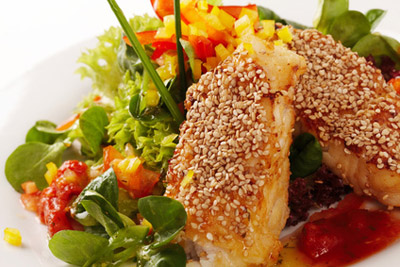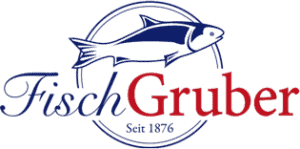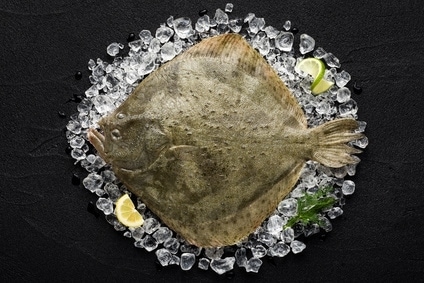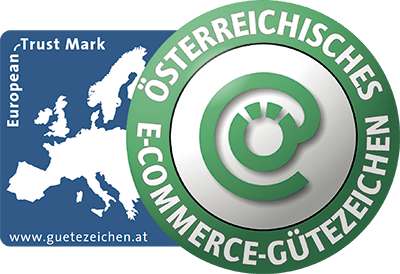Turbot is a left-sided flat fish, having both eyes on this side. The body has no scales and is on the downside white. On the olive green upside, small stone-like humps are very characteristic and giving the turbot his name in many European languages (e.g. German – Steinbutt).
Turbot – his habitat
Turbot prefers moderately warm and not too deep waters, living in depths of 25 to 60 meters on stony or sandy ground. Turbot usually grow up to 12 kilos and 20 years of age. With a diameter of 30-40cm it is sold as “baby-turbot”.
Turbot – a precious, luxury good
Not without reason turbot is considered one of the most exclusive fish and part of every international high-class menu. The famous German TV-cook Johann Lafer called turbot in one of his shows “Champagne of the flat fish, truffle of the deep”. These ones, who generally consider turbot a luxury good will find themselves for some reason confirmed, because only 40-50% of the total weight are precious and delicious meat. It may be his firm, white meat with its unconventional spicy-nutty nuance in taste that makes turbot so special. Even so special that sushi-lovers in Japan and Korea love to eat their turbot raw. Well known as „hirame“ (鮃) it is considered one of the most noble fish.
About 3000 tons of bred fish add up with wild fish – mainly caught in European waters. On the west coast of Jütland/Denmark for example, turbot is caught with special turbot-nets. There turbot fishery is an important economic factor. Also European gourmets start to like turbot more and more as a classic of high-end fish cuisine. Together with sole it is considered the best of all flat fish.

Turbot – a nutritious delicacy!
Turbot is not only a finde delicacy, but also a great source of vital vitamines and trace elements. Moreover the meat is rich with Omega-3 fatty acids! That you know what you actually eat, we provide you on the nutritional facts of turbot. Please note that these can vary according to origin and method of catching (wild/breed).
100g of turbot (eatable parts) contain:
335 KJ/80 kcal
Basic composition
Water 81.6g
Proteins 16.7g
Lipids 1.7g
Cholesterol 54 mg
Polyunsaturated fatty acids (PFA)
0.84mg
Omega-3 fatty acids 0.7g
(composition of fatty acids: 23% saturated, 31.9% monounsaturated, 35.9% Omega-3, 6.2% Omega-6 fatty acids)
Minerals and trace elements
Sodium (Na) 73-114 mg
Potassium (K) 290mg
Magnesium (mg) 19-45 mg
Calcium 17 mg
Phosphor (P) 159 mg
Iron (Fe) 0,2-0,4 mg
Selenium (Se) 0.03 mg
Zinc (Zn) 0.6 mg
Manganese (Mn) <0,05 mg
Copper (Cu) <0,06 mg
Vitamins
Vitamin A 4 µg
Vitamin B1 0,02 mg
Vitamin B2 0,15 mg
Vitamin D 1,7 µg
Vitamin E 0,6 µg
Pantothenic acid 1,0 µg
Pyridoxine 0,3 µg
Amino acids
Aspartic acid (Asp) 1.3 g
Threonine (Thr) 0.7g
Serine (Ser) 0.6 g
Glutamatic acid (Glu) 2.1 g
Proline (Pro) 0.5 g
Glycine (Gly) 0.7 g
Alanine (Ala) 0.8 g
Valine (Val) 0.6 g
Methionine (Met) 0.4 g
Isoleucine (Ile) 0.6 g
Leucine (Leu) 1.1 g
Tyrosine (Tyr) 0.5 g
Phenylalanine (Phe) 0.7 g
Lysine (Lys) 1.3 g
Histidine (His) 0.3 g
Arginine (Arg) 0.9 g
Tryptophan (Trp) 0.2 g
Fisch-Gruber imports every week living turbot from France (Aquafarm), Denmark and Morocco (wild) to Vienna. Turbots starting with a weight from 1.2 kg are available during the whole year on the Vienna Naschmarkt.
© Fisch-Gruber, 2013 – buy turbot in Vienna



